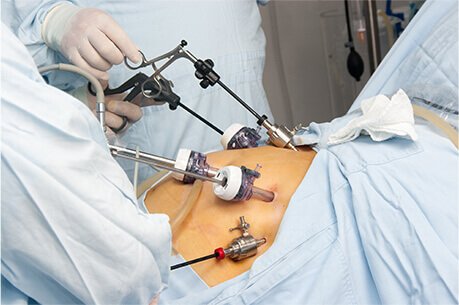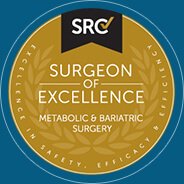Robotic Sleeve Gastrectomy: A Minimally Invasive Approach to Weight Management
Obesity is a complex health condition affecting millions globally, with traditional weight loss methods often proving ineffective for those struggling with severe obesity.
Sleeve gastrectomy, a surgical intervention that reduces the stomach’s size to a tube-like shape, is often considered a safer option. Typically performed using minimally invasive techniques like laparoscopy or robotic surgery, it offers a potential solution for sustainable weight management.
Robotic sleeve gastrectomy has emerged as a promising minimally invasive surgical option. This blog post will delve into the procedure, its benefits, eligibility criteria, recovery process, and long-term success. We’ll also explore the advantages of a minimally invasive approach for achieving optimal weight loss outcomes.
What is a Robotic Sleeve Gastrectomy?
Sleeve gastrectomy involves the removal of approximately 75% of the stomach, leaving a tubular-shaped remnant. Unlike other weight-loss surgeries, it doesn’t alter the anatomy of the small intestine.
Robotic sleeve gastrectomy is a minimally invasive surgical procedure that involves using robotic technology to reshape the stomach into a banana-shaped sleeve. This reduces the stomach’s capacity, promoting feelings of fullness sooner and limiting calorie intake.
Benefits of Choosing a Traditional Sleeve Gastrectomy Approach
- Proven Effectiveness: Traditional or laparoscopic sleeve gastrectomy has a long-standing history of success in helping patients achieve significant weight loss and improve their overall health.
- Minimal Complications: The procedure is generally considered safe and has a low rate of complications.
- Long-Term Benefits: Weight loss achieved through sleeve gastrectomy can lead to improvements in various health conditions, including diabetes, high blood pressure, sleep apnea, knee pain, and backache.
Benefits of Choosing a Robotic Approach
- Enhanced Precision: Robotic technology allows for greater precision and control during the surgical procedure, reducing the risk of complications and improving outcomes.
- Smaller Incisions: Robotic sleeve gastrectomy involves smaller incisions compared to traditional open surgery, leading to a faster recovery time and less scarring.
- Improved Patient Experience: The minimally invasive nature of robotic sleeve gastrectomy often results in a more comfortable postoperative experience and reduced pain.
How Does Robotic Sleeve Gastrectomy Work?
Sleeve gastrectomy involves reducing the size of the stomach, which can lead to changes in hormones that regulate appetite and satiety. This hormonal adjustment can help individuals feel fuller sooner and consume fewer calories, promoting weight loss.
Robotic sleeve gastrectomy (RSG) is performed under general anesthesia. The surgeon makes four small incisions in the abdomen, through which robotic surgical instruments and a camera are inserted. The surgeon then controls these instruments from a nearby console within the operating room, guiding the robotic tools to perform the procedure.
While RSG may take an hour longer than a traditional, open surgery, it offers several advantages, including smaller incisions, reduced pain, and a faster recovery time.
Who is a Candidate for Sleeve Gastrectomy?
Bariatric surgery can be considered an appropriate alternative for:
- BMI above 32.5 kg/m2 with obesity-related co-morbidities
- BMI above 37.5 kg/m2 without co-morbidities
- BMI > 30 kg/m2 with life-threatening obesity-related disorders like uncontrolled diabetes, cardiovascular disease/cardiomyopathy, and severe obstructive sleep apnea
- Patients motivated to lose weight and committed to long-term follow-up
- Patient should have attempted conservative methods of weight loss and failed in the past
- Sleeve Gastrectomy is to be considered only between the ages of 18 – 65 years
- Sleeve Gastrectomy may be considered in patients more than 65 years in the presence of severe obesity-related co-morbidities/disability
- Sleeve Gastrectomy may be considered in patients < 18 years in special situations after pediatrician/endocrinology certification, or after attainment of puberty or completion of skeletal maturity
Bariatric surgery like Sleeve Gastrectomy, offers potential benefits, but it’s essential to weigh these against individual risks. Your weight, age, and medical history play a crucial role in determining your suitability for surgery. To make an informed decision, careful consideration of specific guidelines and patient factors is necessary.
If you are considering bariatric surgery in Delhi, you can find qualified surgeons and facilities by searching for “bariatric surgery near me in Delhi.”
Recovery and Long-Term Success
The recovery process after sleeve gastrectomy typically involves a hospital stay of a couple of days, followed by a period of at-home recovery. During this time, you will need to follow a prescribed diet and gradually increase your physical activity.
Long-term success in weight management after sleeve gastrectomy depends on several factors, including:
- Adherence to Post-Surgery Guidelines: Following your doctor’s recommendations regarding diet, exercise, and follow-up care is essential.
- Lifestyle Changes: Adopting a healthy lifestyle, including regular exercise and a balanced diet, is crucial for maintaining weight loss.
- Ongoing Support: Access to a supportive network, including healthcare professionals and support groups, can help you stay motivated and address any challenges that may arise.
For ongoing care and support, consider consulting with a “top bariatric surgeon in Delhi.”
Common Challenges and How to Overcome Them
Nutrient Deficiencies: After sleeve gastrectomy, it is important to monitor your nutrient intake and take supplements as recommended by your doctor.
Vomiting: Some patients may experience vomiting, especially in the early stages of recovery. This can be managed with dietary adjustments and medications.
Psychological Challenges: Weight loss surgery can be emotionally demanding. Seeking support from a therapist or counselor can help you navigate these challenges.
Conclusion
Sleeve gastrectomy offers a transformative path to improved health and well-being for individuals struggling with obesity. By reducing stomach capacity and regulating hunger and satiety hormones, this procedure can lead to significant weight loss and the resolution of obesity-related health conditions.
Robotic sleeve gastrectomy is a minimally invasive alternative to traditional sleeve gastrectomy. It often provides smaller incisions, reduced pain, and a faster recovery time, making it a more appealing option for many patients.
If you’re considering bariatric surgery, it’s crucial to consult with a qualified surgeon to discuss your individual needs and goals. Remember, every individual’s experience is unique. While sleeve gastrectomy has shown remarkable results for many, it’s important to manage expectations and understand the potential risks and benefits involved. With the right approach and support, sleeve gastrectomy can help you achieve sustainable weight loss and improve your overall quality of life.






